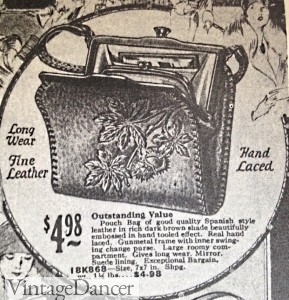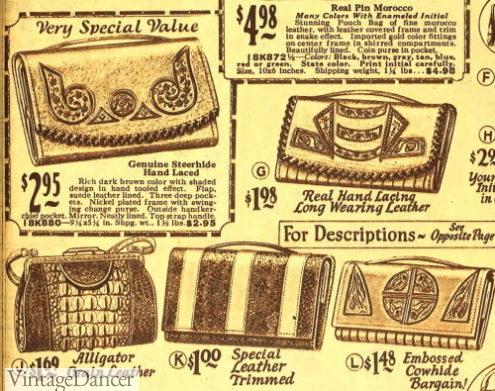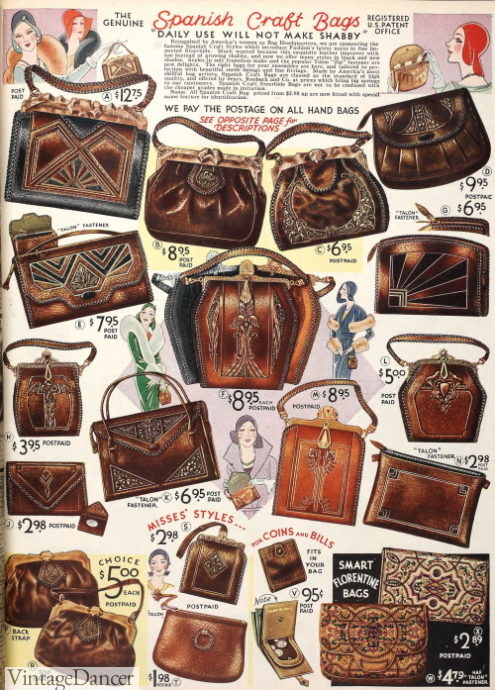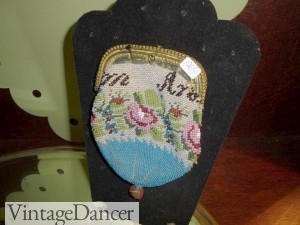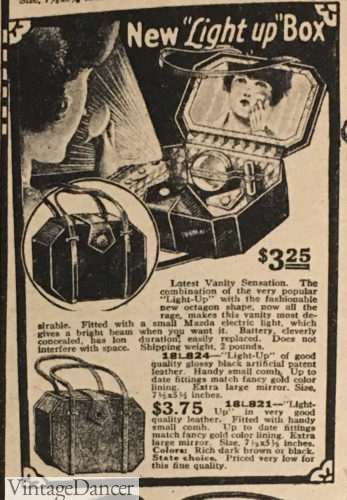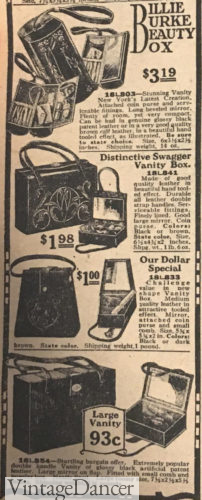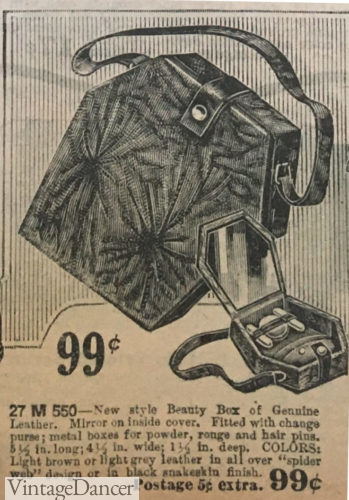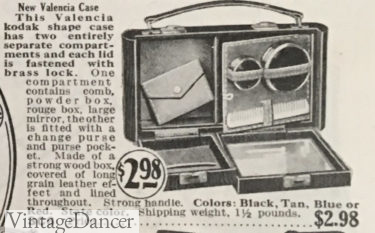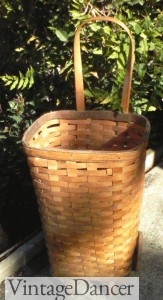Go to any office, coffee shop, or mall today, and you will see women lugging around bags that rival the size of carry-on luggage. A peek inside might reveal a cell phone, car keys, wallet, make up, receipts, energy bars, and a whole host of other gadgets and paraphernalia that are all deemed to be an essential part of a modern woman’s day. By comparison, 1920s handbags, purses, and shopping bags held very little in them.
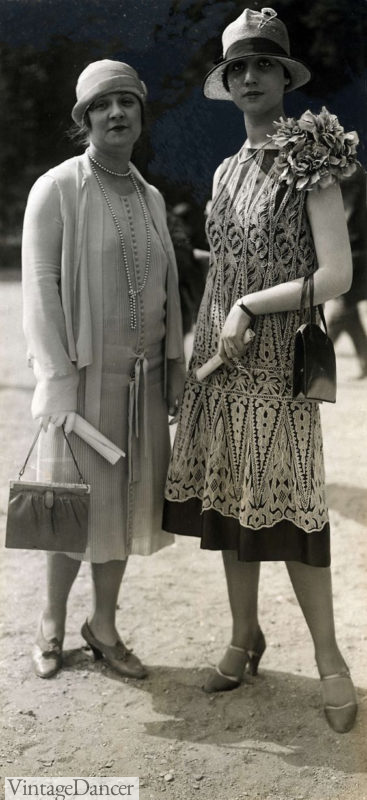
1926 ladies caring handbags
Handbags were just that – bags that you carried in your hand. No tote bags, backpacks, messenger bags, or anything with a shoulder strap for that matter, or at least not until the decade was almost over. A glance inside women’s 1920s handbags probably would have shown some lipstick, a small case of powder, a house key, and a few coins. That’s it.
If it wasn’t for the boom in using makeup, smoking cigarettes, and young women living away from male caretakers (who footed the credit accounts with local merchants), there would be no need for a purse at all. That freed up handbags to be more about fashion than function.
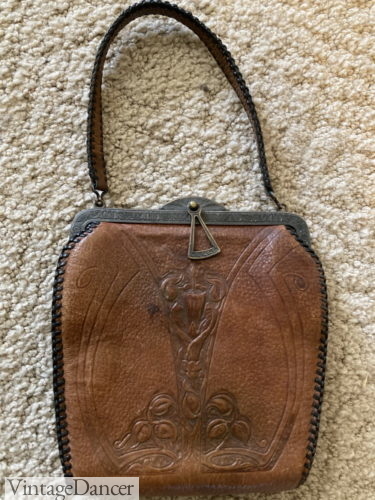
My tooled leather purse (circa 1932) in the 20s style
Daytime appointments usually called for bags made from sturdy fabric or hand tooled leather, while bags for the evening were more glitzy and often made from beads or silver mesh. Bag frames were made of sterling silver, nickel silver, brass, steel, or gunmetal. Many were coated in silver, gold, rhodium, or chrome.
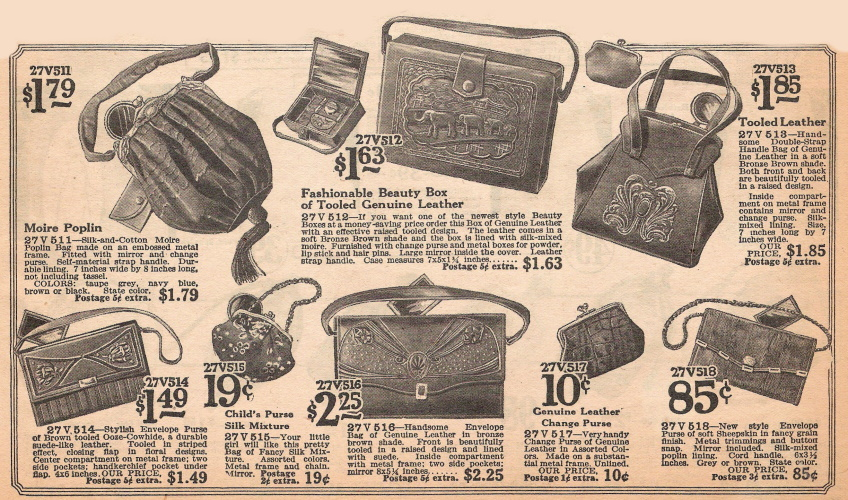
1922 handbags- reticule, clutches, vanity box, tooled leather purses, coin purse
Types of 1920s Handbags – Daytime
The daytime purse was carried by most women every day. They were small, about 5-10 inches wide or tall, and made of leather or fabric. Leathers were die stamped with raised, indented, filigree, or openwork designs. Hand tooling further enhanced many designs, as well as adding enameling and semi-precious stones to the frames.
Handles were usually short, only long enough to carry in the hand instead of thrown over a shoulder. Shapes ranged from rectangular, square, pouch, to occasionally round canisters. They were fairly flat, opening with a frame top and a locking mechanism (notably twist knob, kiss lock, snap lock, zipper, pull key, lift clasp, or slide lock).

1927 short handle bags with the pouch shape
Hand-tooled leather bags were a result of the Arts and Crafts movement that began in the 1880s. The movement embraced handmade, not machine made, products that were decorated with scrolling scenes of nature such as flowers, vines, and insects. Improvements in manufacturing made the machine made bag look handmade in the 1920s at a more affordable price.
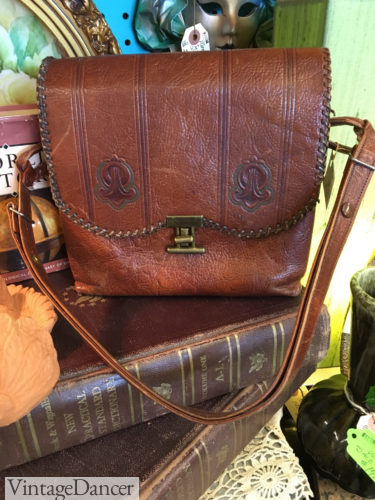
Art and Crafts style hand tooled leather handbag
Calfskin leather made a good durable choice for the body of the bag, while softer pigskin was used for the lacing edges. Sheepskin was also a soft leather and a bit cheaper. Man-made leathers were offered but they were hardly as durable.
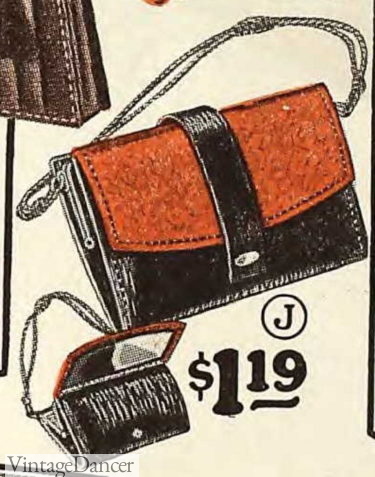
1922 red and black clutch purse with optional chain handle
Black leather was preferred in the early years, with dark or medium brown adding to the mix in the middle years and lighter tans, red-brown, and grey by the end.
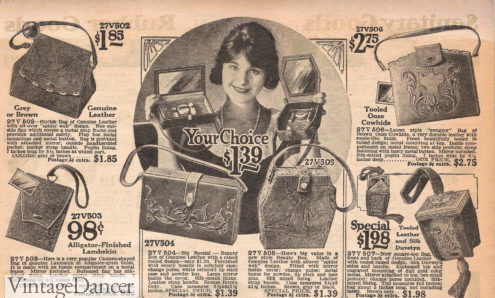
1922 leather handbags and vanity cases with unique shapes
Pouchettes, underarm bags, and clutch bags were names given to a new-ish style of small handbag in the mid 1920s. It was rectangular in shape, like an envelope, and worn tucked under the arm, carried by a small strap across the top, or a vertical strap on the backside.
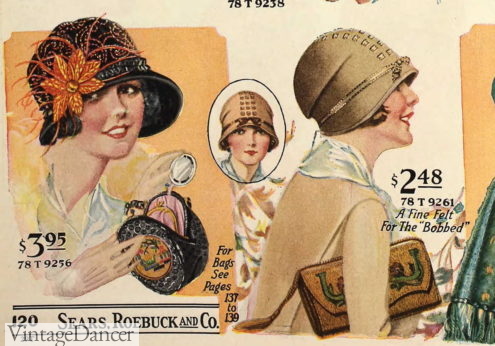
1924 makeup and clutch purse
Pouchettes could be made with embroidered silks, embossed leathers, felt, linen, suede, and woven tapestry with Art Deco style designs. Jeanne Lanvin made a beautiful beaded clutch, and those with money to burn could have even had a silk clutch encrusted with diamonds from Cartier. Textured animal skins also became popular starting in the mid 1920s – lizard, alligator, crocodile, and snakeskin. They mimicked similar trends in footwear.
- 1927 purses clutch
- 1929-1930 leather tooled and colored bags
The clutch purse was so popular that it stayed that way for decades to come. Those who were really in touch with fashion wore matching gloves, which — by the way — were carried in their bags when not in use, not carried in their hands.
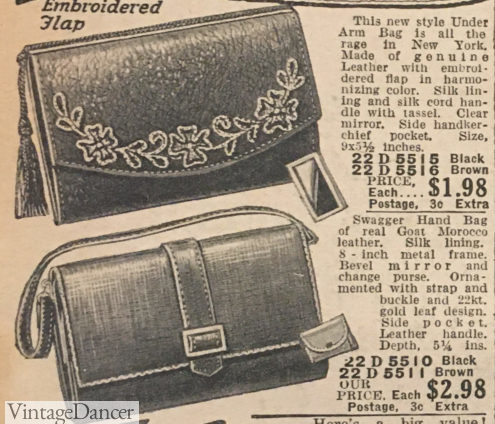
1925 envelope clutch bags with embroidery
The idea of traveling light might sound appealing, but what about the idea of having to carry your bag in your hands all the time? If you don’t like that idea, then you are not alone. None other than Coco Chanel didn’t like it, either. It is established that Chanel often took her designs from menswear, but this time she borrowed from the military messenger bag. Finding it more practical to sling her handbag over her shoulder, she added long thin straps to her bag, and in 1929 introduced the first handbag with shoulder straps. Leave it to Chanel to once again provide both practicality and style.
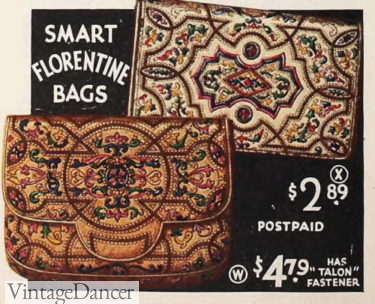
1930 painted to look beaded clutch bags

1929, carrying a clutch purse under arm
Cloth Bags
Reticules functioned like a pouch with a drawstring. They had been the primary style of purse for the past 100 plus years. They remained in style in the early 1920s but quickly drifted away in favor of newer, more practical styles.
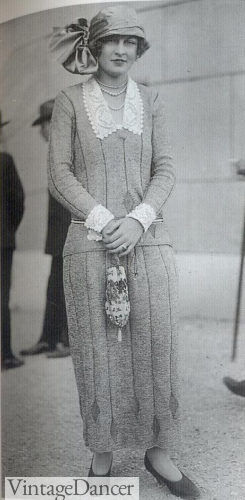
1920s beaded reticule bag pairs with this knit dress
For daytime, reticules were made of fabric such as velvet, silk, satin, cotton, or canvas. Embroidery, tapestry fabrics, and needlework were classic techniques to decorate a handbag. They were popular to make at home, either for matching an outfit or in black for the goes-with-everything evening-wear.
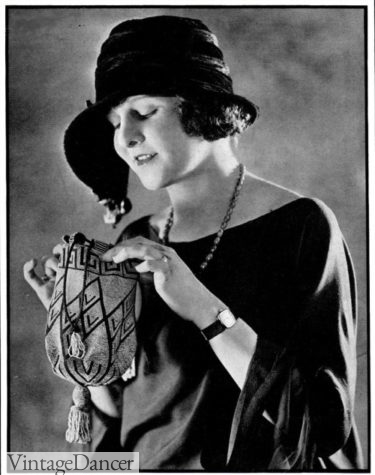
1923 pattern for a beaded reticule bag
At night you might have seen reticules crocheted with strands of glass beads and dangling with fringe. Some reticules had a cylinder container on top that held makeup – a two in one purse! Reticules made of woven metals came in all price ranges. They were used on the silver screen a lot, propelling their popularity throughout the early 1920s.
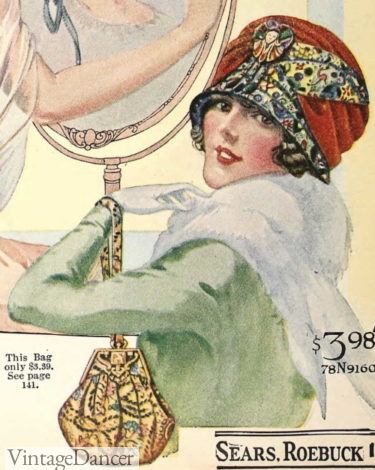
1923 embroidered wrist strap bag
The drawstring was replaced by a frame, updating the reticule into a pouch bag — a much more fashionable design. Suede was a good choice for daywear and velvet for evenings. A matching short fabric handle was added from the frame tips. Inside, they were lined in pretty and soft silk or satin. Outside, a tassel or row of fringe hung from the bottom as a traditional reticule detail.
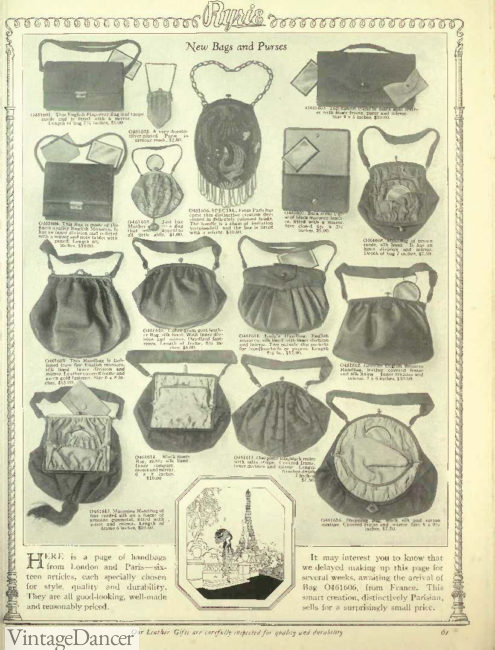
1922 reticule bags and cloth purses
When feed and flour sack bags started to be printed in pretty cotton patterns, many rural women used the material to make dresses and bags. This crafty trend was slow to catch on until the frugal ’30s.
Other crafty women ordered purse kits, which included the materials, beads and frames to make a purse at home. Knitting bags was yet another homemade purse option. They experienced a revival when knitwear became the newest craze in fashion.
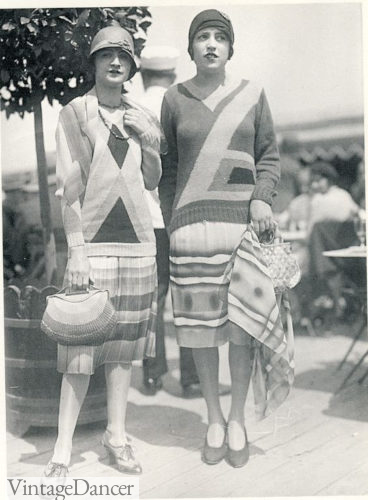
Knit dresses with knitted handbag, mid 1920s
Evening Bags
Evening bags were the stars of the 1920s. Reticules were elaborately decorated as well as pouch bags, small clutches, and coin purses. Beading and metalwork replaced embroidery and fine fabrics as the newest form of embellishment. Designs were pulled from all of the art movements and global influences.
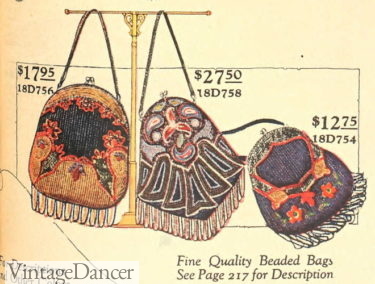
1920 beaded evening bags
Beads for decorating came in all sorts of new man made materials as well as the old stand by glass bead. Opaque, translucent, transparent, carnival glass (iridescent), and opalescent were all forms of beads used. Even seed beads, called Rocaille, decorated ladies’ small bags. Metal beads made of cut steel could now be chemically dyed to look like gold or silver. When mixed with brass and nickel, they had even more metallic colors.
Bags made from metal mesh went back decades but found new popularity in the ’20s. They were plated with gold and silver, or perhaps enameled with the popular Art Deco patterns such as Egyptian and Asian motifs. The variety of mesh bags made in the 1920s is a fascinating study for a collector.
The mesh bag was usually long and slender. Some frames were rectangular, while others were dome or cathedral shaped. Genuine or synthetic sapphire cabochons were often set into the knob clasp. A short chain handle or wrist strap added to the bags dainty charm. Fringe chain was added to the hem of many bags.
Dresden mesh was found on the finest of mesh bags with pearlized or enamel finishes. The result was soft muted or washed colors similar to Chine fabric.
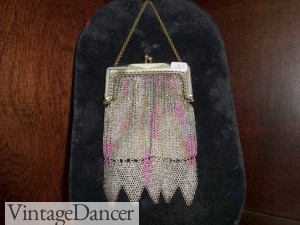
Metal ring mesh bag with enameled coloring
Armored mesh was made of small flat metal links in “+” or “x” shapes. They could be stenciled or enameled into geometric Art Deco patterns. Beadlite mesh had a raised dome center that looked like beads.
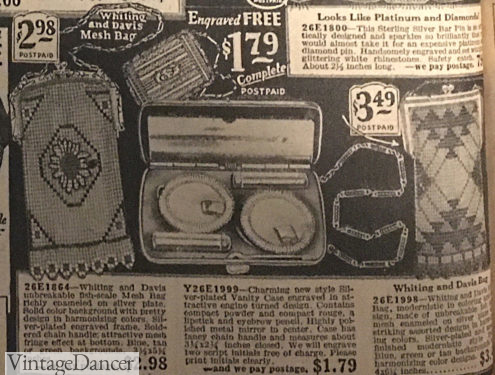
1929 Whiting and Davis mesh bags, Art Deco patterns
Ring mesh was made of tiny circles linked together and sometimes colored, giving the look of a watercolor painting.
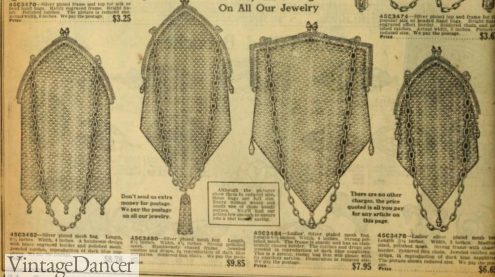
1920 silver plated mesh bags
Sunset mesh bags were introduced by Whiting & Davis in 1921. Fine gold, silver, and bronze plated rings were arranged in vertical stripes.
![1929 A lovely afternoon frock paired with a mesh handbag (Mrs. Oscar [Jessie Williams] De Priest)](https://vintagedancer.com/wp-content/uploads/1929-Mrs-Oscar-Jessie-Williams-De-Priest-was-the-wife-of-Chicago-Congressman-Oscar-De-Priest-published-in-the-Chicago-Daily-Defender-June-22-1929-at-white-house-luncheon-purse-hat-white-dress-noir-500-289x500.jpg)
1929 A lovely afternoon frock paired with a mesh handbag (Mrs. Oscar [Jessie Williams] De Priest)
Vanity Bags
The growth of the makeup industry in the 1920s meant women were using makeup regularly, to the point where a woman would need to touch up her face several times a day. Purses and handbags were designed with matching mirror cases, sometimes attached to a chain so it could not be misplaced. Daytime ladies’ bags had pockets and compartments designed to hold compacts, coin purses, key cases, handkerchiefs, combs, and cigarette cases – everything a woman could need, neatly organized.
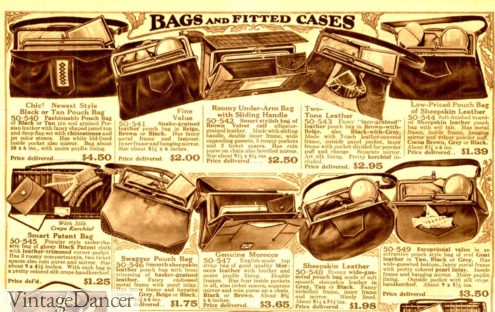
1928 purses with matching mirrors and compartments for cases and compacts.
Women could take along one or two essential makeup compacts in her small everyday bag, however more serious makeup users turned to a new bag, the vanity bag, for her needs. The bag was more like a box, hexagon, octagon, or round cylinder with strap handle. Inside, the vanity box straps held down compacts, tubes, pouches and/or cases of makeup, tonics, buffs, and a hair comb. Some even came with a light and large mirror for on-the-go applications.
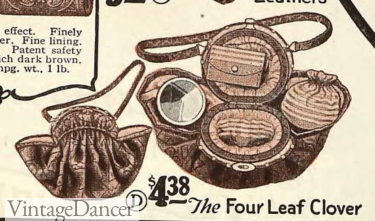
1922 compact bags
- 1923 light-up vanity box
- 1923 Bille Burke vanity cases
- 1922 makeup box with mirror flap
- 1928 vanity box with inside compartments
Many mesh and beaded evening bags also had built in compartments for makeup, called a Piccadilly vanity bag. A rectangle shaped compact became part of the top frame or a round cylinder screwed on top of the reticule bag. The compact housed a tiny mirror and puff, pre-loaded with powder. Additional compacts could be stored inside the bag. These richly ornamented bags hid in plain sight the fact that a woman used makeup. How daring!
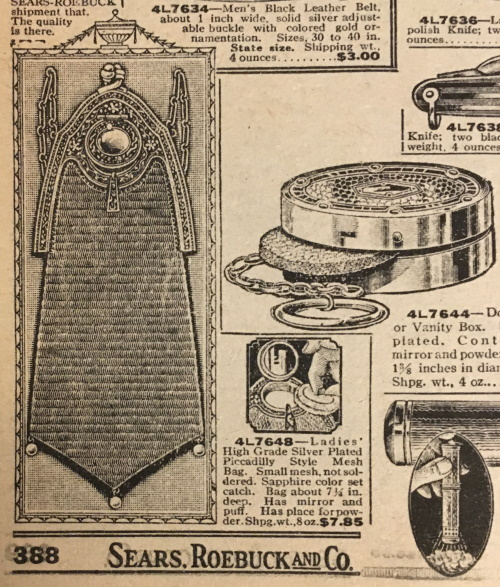
1923 mesh Piccadilly style bag with build in powder compact and mirror.
Continue on to read about 1930s handbags.
Shopping Bags and Carts
A small handbag would not do a woman any good when she was shopping for groceries, carrying books to school, going on a short trip, or on an outing with a baby. Large quantity shopping also needed larger bags. Mid-sized shopping bags (about 12 inches) with handle or strap served well for short errands. Small compartments inside kept some cash and coin within reach.
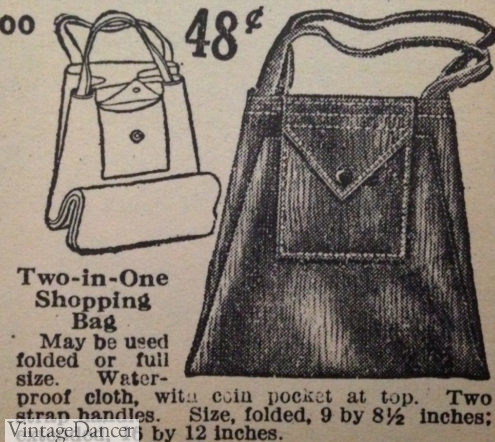
The fold-out shopping bag was designed to collapse into a small purse and open up to a 16″ by 12″ shopping bag for carrying grocery items home. It was made of a rubberized cloth instead of leather.
A woven straw shopping basket remained popular for women, especially in Europe.
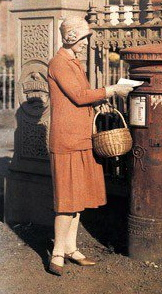
Mailing letters carried in her shopping basket
For groceries, many stores provided delivery service, a great convenience for women without cars. For women in town, a shopping cart would have been preferred over a heavy leather bag or hand basket. This cart below was my great grandmother’s woven wood shopping cart. She used it for all her errands.
For travel, shopping, or school items, the Boston bag was the item all women, men, and children used. It looked like an old doctor’s medicine bag (AKA Gladstone bag). Gladstone bags or club bags had a lockable frame, while the Boston bag latched with a buckle strap. Made of sturdy cowhide leather with a frame top, two thick handles, and metal feet, it held a lot and lasted for decades.
Women and men used it for travel by car, train or ship, when only a weekend’s worth of clothing was needed.
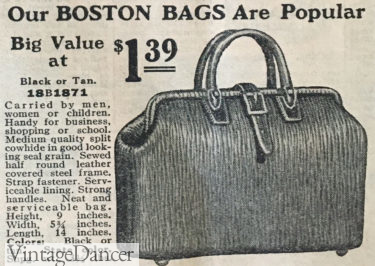
1923, Boston bag
Similar to the Boston bag were other large travel bags that resembled extra large purses. Many women chose these large bags over smaller bags for their everyday needs, especially in America.
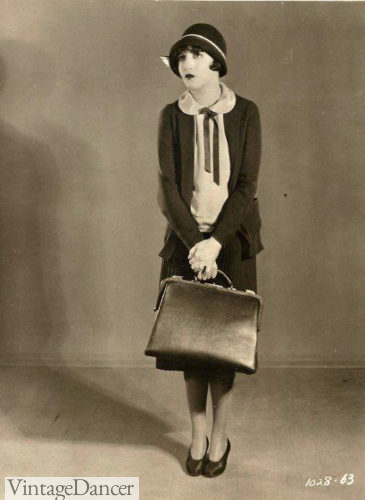
Carrying a travel bag
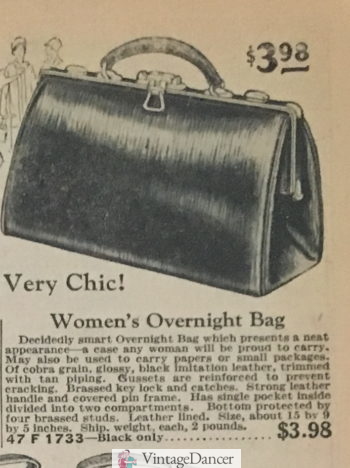

Traveling by ship these ladies brought a large purse and a briefcase bag
There were bags for many other occasions. A briefcase was used by men and women who carried books and papers.
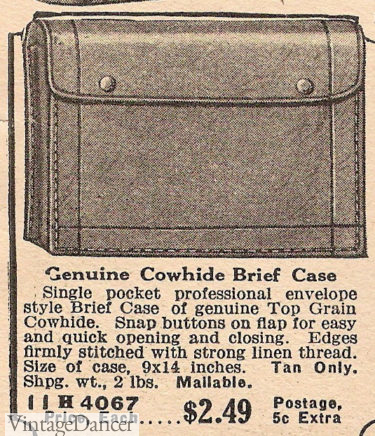
1927 briefcase
A roll up or flat briefcase style bag carried sheet music.
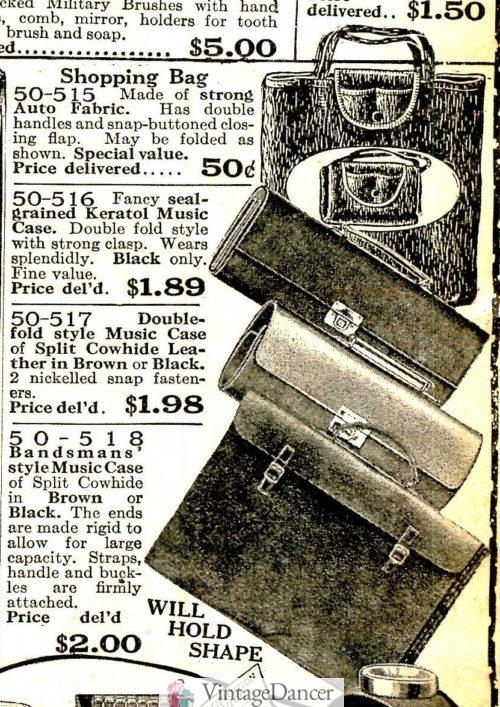
Top to bottom: shopping bag, rolled music cases, flat music case.
1920s Reproduction Bags
There are a few designers who have made an art of reviving 1920s style handbags. They are by no means cheap, but they are utterly beautiful recreations. The first is Whiting and Davis established in 1896. They were a first producer of metal mesh bags and continue to make reproduction and new mesh bags. Vintage Whiting and Davis bags from the teens on up to now are readily found in vintage shops. I frequently use my metal mesh bag from the 1960s as a 1920s evening purse – the styles were very similar.
The other designer is Mary Frances. She has several bags which are reproductions of 1920s beaded bags, but most of her designs are just inspired by the ’20s techniques. She has a great sense of humor and whimsy which are evident in her small purses. Many are truly elegant works of art.
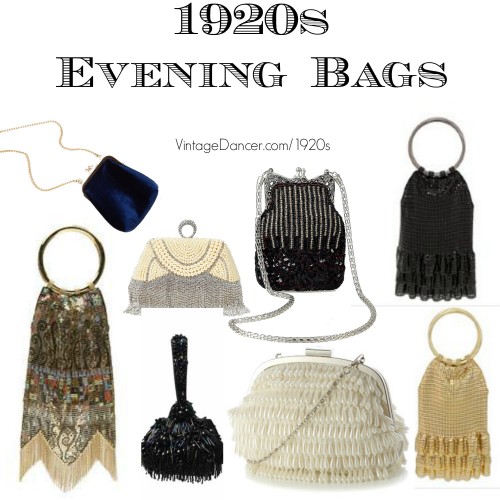
1920s Style Bags
On the cheaper end are embroidered frame bags, beaded bags, clutch bags, and occasionally box bags. Indian Potli bags can also serve as affordable Reticule style bags for early ’20s looks. These are all great for evenings.
The leather day purse is the only one I have a hard time finding. Some vintage bags from the 1970s or western style bags can work, but they are usually too large and too modern. Genuine vintage 1920s bags are amazing but not cheap, and often too small to carry modern cell phones. It took me quite a while to find one that would hold all of my modern conveniences.
Here are some good 1920s inspired handbags for sale:
1920s Style Handbags
Search for vintage 192s handbags with our search engine.
Debbie Sessions has been teaching fashion history and helping people dress for vintage themed events since 2009. She has turned a hobby into VintageDancer.com with hundreds of well researched articles and hand picked links to vintage inspired clothing online. She aims to make dressing accurately (or not) an affordable option for all. Oh, and she dances too.
